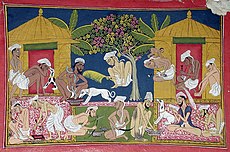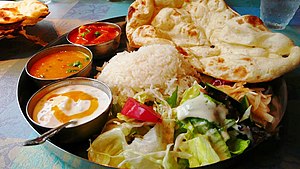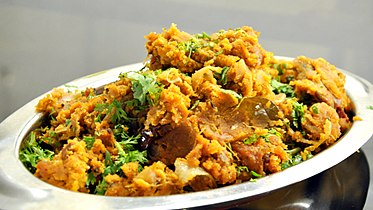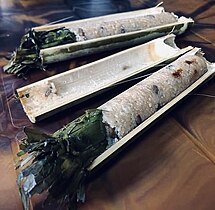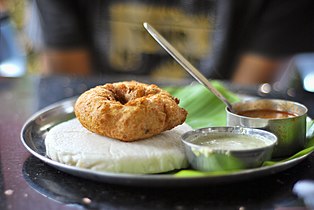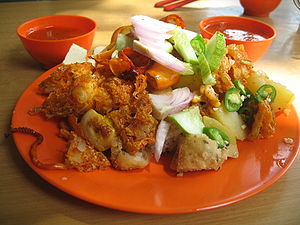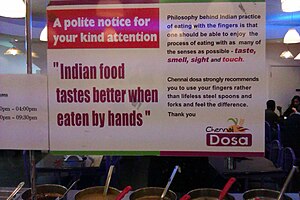インド料理
Indian cuisine/ja
| この記事はシリーズの一部である |
| インド料理 |
|---|
 |
|
|
| 以下一連のシリーズの一部 |
| インドの文化 |
|---|
 |
|
|
インド料理とは、インドに固有の多様な地域料理および伝統料理から成るものである。土壌、気候、文化、民族集団、職業の多様性により、これらの料理は大きく異なり、現地で入手可能な香辛料、ハーブ、野菜、果物を用いている。
インド料理は、宗教、特にヒンドゥー教およびイスラム教、文化的な選択や伝統の影響を強く受けている。
侵略、貿易関係、植民地主義といった歴史的出来事は、特定の食材をこの国にもたらす役割を果たしてきた。コロンブスの新大陸発見により、新世界から多くの新しい野菜や果物がインドにもたらされた。ジャガイモ、トマト、トウガラシ、ピーナッツ、グアバなどの多くは、インドの多くの地域で主食のひとつとなっている。
インド料理は国際関係の歴史に影響を与えてきた。インドとヨーロッパとの間の香辛料貿易は、ヨーロッパの大航海時代の主なきっかけとなった。香辛料はインドから購入され、ヨーロッパやアジア各地で取引された。インド料理は世界各地の料理に影響を与えており、特にヨーロッパ(特にイギリス)、中東、南部アフリカ、東アフリカ、東南アジア、北アメリカ、モーリシャス、フィジー、オセアニア、カリブの料理に強い影響を及ぼしている。
歴史
インド料理は、インド亜大陸におけるさまざまな集団や文化が関わってきた8,000年にわたる歴史を反映しており、現代インドに見られる多様な風味や地域料理を生み出している。後には、イギリス人やポルトガル人との貿易により、すでに多様であったインド料理にさらなる影響が加わった。
先史時代およびインダス文明
関連項目:メルッハ、インダス・メソポタミア関係、インドの海洋史
紀元前9000年以降、肥沃な三日月地帯とインダス文明の間で、新石器革命および農業の拡散の結果として、間接的な接触の初期段階があったと考えられている。紀元前7000年頃には、農業が肥沃な三日月地帯からインダス地域へと広がり、小麦や大麦の栽培が始まった。ゴマや瘤牛(ズブ牛)は、現地の農耕社会で家畜化された。メヘルガルは、南アジアにおける最古級の農耕・牧畜の痕跡が確認された遺跡のひとつである。紀元前4500年頃から1900年頃にかけて、シュメール文明を築いたシュメール人は、インド・ヨーロッパ語族にもセム語族にも属さない言語を話しており、当初はインドから来た可能性があり、インドのドラヴィダ系民族の祖先と関係していた可能性がある。
紀元前3000年頃までに、ウコン、カルダモン、黒コショウ、マスタードがインドで収穫されていた。
紀元前2350年頃以降、インダスからメソポタミアのウルへの輸入品の証拠が見つかっており、海洋東南アジアのモルッカ諸島原産と考えられるクローブ(丁子)の花頭が、紀元前2千年紀のテルカの遺跡で発見されている。アッカド帝国の記録には、メルッハからメルッハ船によって輸入された木材、カーネリアン、象牙について言及されており、メルッハは一般にメソポタミアにおけるインダス文明の名称とされている。
ヴェーダ時代
古代のヒンドゥー教文献『’’マハーバーラタ’’』には、米と野菜を一緒に炊いた料理について言及されており、"プラオ"または"パッラオ"という語が、サンスクリットの古典文献、たとえば『ヤージュニャヴァルキヤ・スムリティ』などに見られる。アーユルヴェーダは、食事、瞑想、ヨガを含むホリスティックな健康アプローチを扱う古代インドの養生体系である。
古代
インドにおける初期の食生活は、主に豆類、野菜、果物、穀物、乳製品、および蜂蜜で構成されていた。今日の主食には、さまざまなレンズ豆(’’ダール’’)、全粒小麦粉(’‘aṭṭa’’)、米、そしてシコクビエ(’‘bājra’’)が含まれ、これらは紀元前6200年からインド亜大陸で栽培されてきた。
時代が進むにつれて、シュラマナ運動の影響で、一部の人々は菜食主義を受け入れるようになった。温暖な気候が多種多様な果物、野菜、穀物の通年栽培を可能にした。
ヨーガの伝統において、食品を’’サットヴィック’’、’’ラジャシック’’、’’タマシック’‘に分類する食物分類法が発展した。’’バガヴァッド・ギーター’’では、特定の食事法が規定されている(第17章、第8–10節)。
牛肉の消費は禁忌とされており、これはヒンドゥー教において牛が神聖視されているためである。インドのヒンドゥー教徒は通常牛肉を食べないが、ケーララ州、南部タミル・ナードゥ州の一部、北東部では例外がある。
古代インドの経典に登場する食品

多くの古代インドのレシピは歴史の中で失われたが、古代および先史時代のインドで何が食べられていたかは、古代の文献からうかがい知ることができる。
- 大麦 — (ヴェーダ語および古典サンスクリット語で’‘ヤヴァ’‘と呼ばれる)’’リグ・ヴェーダ’‘や他のインドの聖典において、古代インドの主要穀物の1つとしてたびたび言及されている
- ベテルの葉 — 主にビンロウジやタバコを噛む際の包みとして用いられるが、料理にも使われ、特に生でピリッとした風味を加える
- パンノキ(パンの実) — コンカニ語で’‘jeev kadge phodi’‘と呼ばれる揚げ物がカルナータカ州およびケーララ州の沿岸部での郷土料理
- ヒヨコマメ — ‘’ミルチ・バジ’‘や’‘mirapakaya bajji’‘のように、粉にして人気のある料理が作られる
- カード — インド亜大陸に由来する伝統的なヨーグルトまたは発酵乳製品で、通常は牛乳から、時には水牛やヤギの乳から作られる
- イチジク — アフガニスタンからポルトガルまで栽培されており、インドのクマオン丘陵のピトラガルでも育てられている
- ギー — 古代インド発祥の澄ましバターの一種で、インド亜大陸、中東料理、伝統医学、宗教儀式で広く用いられる
- ブドウ酒 — カウティリヤの紀元前4世紀後半の記述にインドでのブドウ由来のワインの初出が見られる
- 蜂蜜 — ヴェーダおよびアーユルヴェーダ文献に、精神的かつ治療的用途が記録されている
- マンゴー — ジャイナ教の女神アンビカーは、伝統的にマンゴーの木の下に座る姿で表される
- カラシ(マスタード) — 褐色カラシナはインダス文明で栽培されていた香辛料で、現在もインド亜大陸で重要なスパイス
- ザクロ — 一部のヒンドゥー教伝統では、大地の女神ブーミデヴィやガネーシャ神と関連づけられ、繁栄と多産の象徴
- 米 — 紀元前5000年頃からインド亜大陸で栽培
- ライスケーキ — 多様な種類が存在する
- ローズアップル — 果物として食され、また’‘chambakka achar’‘として漬物にもされる
- サフラン — スペインからカシミールにかけての帯状地域で主に栽培される
- 塩 — ヒンドゥー教では非常に縁起の良い物質とされ、上棟式や結婚式などの宗教儀式で使われる。またジャイナ教では、信仰の印として生米と一緒に供えたり、火葬後の遺灰に振りかけたりする習慣がある
- ゴマ油 — 韓国、中国、そしてカルナータカ、アーンドラ・プラデーシュ、タミル・ナードゥなどの南インドで人気で、オリーブオイルの地中海での使用に似ている
- ソルガム(モロコシ) — 一般に’‘jwaarie’’、’‘jowar’’、’‘jola’’、’‘jondhalaa’’と呼ばれ、主要な栄養源のひとつ
- 砂糖 — 古代からインド亜大陸で生産され、カイバル峠を通じて現代のアフガニスタンへと広まった
- サトウキビ — 最古の結晶糖の生産は北インドで始まった。古代サンスクリット語とパーリ語の文献にその証拠が見られる
- ウコン(ターメリック) — 南アジアと中東料理で広くスパイスとして使用される
中世から16世紀まで
中世インドにおいては、グプタ朝をはじめとする複数の王朝が栄えた。この時代のインドへの渡航により、茶などの新たな料理法や食材が地域にもたらされた。
その後、中央アジアの文化を持つ諸部族がインドに侵入し、インド料理と中央アジア料理が融合したムガル料理が誕生した。サフランなどの香辛料を多用することが特徴である。
植民地時代
ポルトガル人およびイギリス人の支配下では、ベーキングのような新たな調理法や、新大陸およびヨーロッパ由来の食品が導入された。インド亜大陸の料理で人気のある新大陸産の野菜には、トマト、ジャガイモ、サツマイモ、ピーナッツ、カボチャ、チリなどがある。サツマイモ、ジャガイモ、アマランサス、ピーナッツ、キャッサバを原料とするサゴといった多くの新大陸野菜は、ヒンドゥー教の断食日に摂取が許されている。カリフラワーは1822年にイギリス人によって導入された。18世紀末から19世紀初頭には、スコットランド人ロバート・リンジーの自伝に、シレット地方出身のサイード・ウッラーという人物がリンジー家のためにカレーを調理したという記録があり、これはイギリスにおけるインド料理の最古の記録の一つと考えられている。
-
ニマトナーマー・イ・ナースィルッディーン・シャーヒーより一頁。キールの作り方という美食とレシピの芸術が記録されている。
食材

インド料理の主食には、バジュラ(シコクビエ)、米、アッタ(全粒小麦粉)、およびさまざまな種類のレンズ豆(例:’‘マスール’’(主に赤レンズ豆)、’‘トゥール’’[トゥワール豆]、’’ウラド’’(黒グラム)、’‘ムング’’[緑豆])などがある。レンズ豆は、全形、皮むき(例:’‘ドゥーリ・ムング’‘や’‘ドゥーリ・ウラド’’)、または割った状態で使用される。割ったレンズ豆(’‘ダール’’)は広く使われている。その他の豆類では、’‘チャナ’‘や’‘チョーレ’’(ヒヨコ豆)、’’ラジマ’’(インゲンマメ)、’‘ロビヤ’’(ササゲ)が特に北インドで一般的である。’‘チャナ’‘と’‘ムング’’はベサン(ひよこ豆粉)としても加工される。
多くのインド料理は植物油で調理されるが、ピーナッツ油は北部および西部インドで人気があり、マスタード油は東インド、ココナッツ油は西海岸、特にケーララ州や南部タミル・ナードゥ州でよく使われている。ギンゲリー(ごま)油は香ばしくナッツのような香りがするため、南インドで広く用いられている。
近年では、ひまわり油、ベニバナ油、綿実油、大豆油などもインド全土で人気を博している。硬化植物油である’’ヴァナスパティ・ギー’‘もよく使用されている。バターをベースとしたギー、すなわち’‘デシ・ギー’’も一般的である。
インド料理では多様な肉類が使われるが、最も一般的に消費されているのは鶏肉とマトンである。魚介類や牛肉も一部地域では食されるが、沿岸部や北東部を除いては広く消費されているわけではない。
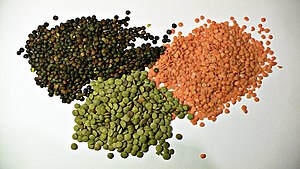
インド料理で最も重要かつ頻繁に使用される香辛料・風味付け食材には、唐辛子(’‘ミルチ’’。コロンブス交易を通じて16世紀にメキシコからポルトガル人によりもたらされた)、黒マスタードシード(’‘サルソ’’)、カルダモン(’‘エライチ’’)、クミン(’‘ジーラ’’)、ターメリック(’‘ハルディ’’)、ヒング、ショウガ(’‘アドラク’’)、コリアンダー(’‘ダニヤ’’)、ニンニク(’‘ラスーン’’)などがある。
よく使われるスパイスミックスのひとつが’’ガラムマサラ’‘であり、通常は7種の乾燥香辛料を特定の割合で混ぜた粉末である。これには黒カルダモン、シナモン(’‘ダルチニ’’)、クローブ(’‘ラウング’’)、クミン(ジーラ)、黒胡椒、コリアンダーシード、八角などが含まれる。
地域ごとに’‘ガラムマサラ’‘の配合は異なり、各料理人が独自のブレンドを持つこともある。’‘ゴダ・マサラ’‘はマハーラーシュトラ州で人気の、甘みを帯びた類似スパイスミックスである。風味付けに使用される代表的な葉には、ベイリーフ(’’テージパッタ’’)、コリアンダーの葉、フェヌグリーク(’’メティ’’)の葉、ミントの葉がある。カレーリーフとその根は、グジャラート料理や南インド料理に特有の風味付けに用いられる。甘味料理には、カルダモン、サフラン、ナツメグ、バラの花弁エッセンスなどがしばしば用いられる。
地域料理
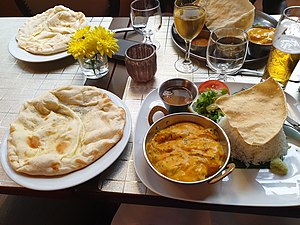
Cuisine differs across India's diverse regions as a result of variation in local culture, geographical location (proximity to sea, desert, or mountains), and economics. It also varies seasonally, depending on which fruits and vegetables are ripe.
Andaman and Nicobar Islands
Seafood plays a major role in the cuisine of the Andaman and Nicobar Islands. Staples of the diet of the Indigenous Andamanese traditionally include roots, honey, fruits, meat, and fish, obtained by hunting and gathering. Some insects were also eaten as delicacies. Immigration from mainland of India, however, has resulted in variations in the cuisine.
Andhra Pradesh
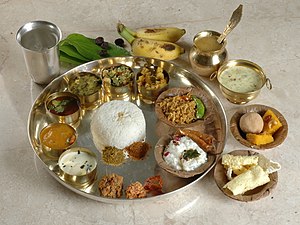
The cuisine of Andhra Pradesh belongs to the two Telugu-speaking regions of Rayalaseema and Coastal Andhra and is part of Telugu cuisine. The food of Andhra Pradesh is known for its heavy use of spices, and the use of tamarind.
Seafood is common in the coastal region of the state. Rice is the staple food (as is with all South Indian states) eaten with lentil preparations such as pappu (lentils) and pulusu (stew) and spicy vegetables or curries.
In Andhra, leafy greens or vegetables such as bottle-gourd and eggplant are usually added to dal. Pickles are an essential part of the local cuisine; popular among those are mango-based pickles such as avakaya and maagaya, gongura (a pickle made from sorrel leaves), usirikaya (gooseberry or amla), nimmakaya (lime), and tomato pickle.
Perugu (yogurt) is a common addition to meals, as a way of tempering spiciness. Breakfast items include dosa, pesarattu (mung bean dosa), vada, and idli.
Arunachal Pradesh

The staple food of Arunachal Pradesh is rice, along with fish, meat, and leaf vegetables. Native tribes of Arunachal are meat eaters and use fish, eggs, beef, chicken, pork, and mutton to make their dishes.
Many varieties of rice are used. Boiled rice cakes wrapped in leaves are a popular snack. Thukpa is a kind of noodle soup common among the Monpa tribe of the region.
Lettuce is the most common vegetable, usually prepared by boiling with ginger, coriander, and green chillies.
Apong or rice beer made from fermented rice or millet is a popular beverage in Arunachal Pradesh and is consumed as a refreshing drink.
Assam
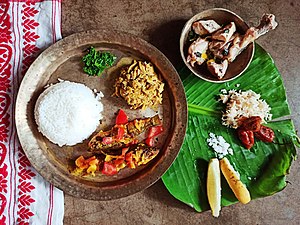
Assamese cuisine is a mixture of different indigenous styles, with considerable regional variation and some external influences. Although it is known for its limited use of spices, Assamese cuisine has strong flavours from its use of endemic herbs, fruits, and vegetables served fresh, dried, or fermented.
Rice is the staple food item and a huge variety of endemic rice varieties, including several varieties of sticky rice are a part of the cuisine in Assam. Fish, generally freshwater varieties, are widely eaten. Other non-vegetarian items include chicken, duck, squab, snails, silkworms, insects, goat, pork, venison, turtle, monitor lizard, etc.
The region's cuisine involves simple cooking processes, mostly barbecuing, steaming, or boiling. Bhuna, the gentle frying of spices before the addition of the main ingredients, generally common in Indian cooking, is absent in the cuisine of Assam.
A traditional meal in Assam begins with a khar, a class of dishes named after the main ingredient and ends with a tenga, a sour dish. Homebrewed rice beer or rice wine is served before a meal. The food is usually served in bell metal utensils.
Bengal

Mughal cuisine is a universal influencer in the Bengali palate, and has introduced Persian and Islamic foods to the region, as well as a number of more elaborate methods of preparing food, like marination using ghee. Fish, meat, rice, milk, and sugar all play crucial parts in Bengali cuisine.
Bengali cuisine can be subdivided into four different types of dishes, charbya (চারব্য), or food that is chewed, such as rice or fish; choṣya, or food that is sucked, such as ambal and tak; lehya (লেহ্য), or foods that are meant to be licked, like chuttney; and peya (পেয়ে), which includes drinks, mainly milk.

During the 19th century, many Odia-speaking cooks were employed in Bengal, which led to the transfer of several food items between the two regions. Bengali cuisine is the only traditionally developed multi-course tradition from the Indian subcontinent that is analogous in structure to the modern service à la russe style of French cuisine, with food served course-wise rather than all at once.
Bengali cuisine differs according to regional tastes, such as the emphasis on the use of chilli pepper in the Chittagong district of Bangladesh However, across all its varieties, there is predominant use of mustard oil along with large amounts of spices.
The cuisine is known for subtle flavours with an emphasis on fish, meat, vegetables, lentils, and rice. Bread is also a common dish in Bengali cuisine, particularly a deep-fried version called luchi is popular. Fresh aquatic fish is one of its most distinctive features; Bengalis prepare fish in many ways, such as steaming, braising, or stewing in vegetables and sauces based on coconut milk or mustard.
East Bengali food, which has a high presence in West Bengal and Bangladesh, is much spicier than the West Bengali cuisine, and tends to use high amounts of chilli, and is one of the spiciest cuisines in India and the World.
Shondesh and Rashogolla are popular dishes made of sweetened, finely ground fresh cheese. For the latter, West Bengal and neighboring Odisha both claim to be the origin of dessert. Each state also has a geographical indication for their regional variety of rasgulla.
The cuisine is also found in the state of Tripura and the Barak Valley of Assam.
Bihar

Bihari cuisine may include litti chokha, a baked salted wheat-flour cake filled with sattu (baked chickpea flour) and some special spices, which is served with baigan bharta,
Among meat dishes, meat saalan is a popular dish made of mutton or goat curry with cubed potatoes in garam masala.
Dalpuri is another popular dish in Bihar. It is salted wheat-flour bread, filled with boiled, crushed, and fried gram pulses.
Malpua is a popular sweet dish of Bihar, prepared by a mixture of maida, milk, bananas, cashew nuts, peanuts, raisins, sugar, water, and green cardamom. Another notable sweet dish of Bihar is balushahi, which is prepared by a specially treated combination of maida and sugar along with ghee, and the other worldwide famous sweet, khaja is made from flour, vegetable fat, and sugar, which is mainly used in weddings and other occasions. Silao near Nalanda is famous for its production.
During the festival of Chhath, thekua, a sweet dish made of ghee, jaggery, and whole-meal flour, flavoured with aniseed, is made.
Other food items that are quite prominent in Bihar are, Pittha, Aaloo Bhujiya, Reshmi Kebab, Palwal ki mithai, and Puri Sabzi.
Chandigarh

Chandigarh, the capital of Punjab and Haryana is a city of 20th-century origin with a cosmopolitan food culture mainly involving North Indian cuisine. People enjoy home-made recipes such as paratha, especially at breakfast, and other Punjabi foods like roti which is made from wheat, sweetcorn, or other glutenous flour with cooked vegetables or beans. Sarson da saag and dal makhani are well-known dishes among others. Popular snacks include gol gappa (known as panipuri in other places). It consists of a round, hollow puri, fried crisp and filled with a mixture of flavoured water, boiled and cubed potatoes, bengal gram beans, etc.
Chhattisgarh

Chhattisgarh cuisine is unique in nature and not found in the rest of India, although the staple food is rice, like in much of the country. Many Chhattisgarhi people drink liquor brewed from the mahuwa flower palm wine (tadi in rural areas). Chhattisgarhi cuisines varies as per special occasions and festivals like Thethari and Khurmi, fara, gulgule bhajiya, chausela, chila, aaersa are prepared in regional festivals. The tribal people of the Bastar region of Chhattisgarh eat ancestral dishes such as mushrooms, bamboo pickle, bamboo vegetables, etc.
Dadra and Nagar Haveli
The local cuisine resembles the cuisine of Gujarat. Ubadiyu is a local delicacy made of vegetables and beans with herbs. The common foods include rice, roti, vegetables, river fish, and crab. People also enjoy buttermilk and chutney made of different fruits and herbs.
Daman and Diu
Daman and Diu is a union territory of India which, like Goa, was a former colonial possession of Portugal. Consequently, both native Gujarati food and traditional Portuguese food are common. Being a coastal region, the communities are mainly dependent on seafood. Normally, rotli and tea are taken for breakfast, rotla and saak for lunch, and chokha along with saak and curry are taken for dinner. Some of the dishes prepared on festive occasions include puri, lapsee, potaya, dudh-plag, and dhakanu. While alcohol is prohibited in the neighbouring state of Gujarat, drinking is common in Daman and Diu. Better known as the "pub" of Gujarat. All popular brands of alcohol are readily available.
Delhi

Delhi was once the capital of the Mughal empire, and it became the birthplace of Mughlai cuisine. Delhi is noted for its street food. The Paranthewali Gali in Chandani Chowk is just one of the culinary landmarks for stuffed flatbread (parathas).
Delhi has people from different parts of India, thus the city has different types of food traditions; its cuisine is influenced by the various cultures. Punjabi cuisine is common, due to the dominance of Punjabi communities.
Delhi cuisine is actually an amalgam of different Indian cuisines modified in unique ways. This is apparent in the different types of street food available. Kababs, kachauri, chaat, Indian sweets, Indian ice cream (commonly called kulfi), and even Western food items like sandwiches and patties, are prepared in a style unique to Delhi and are quite popular.
Goa

The area has a tropical climate, which means the spices and flavours are intense. Use of kokum is a distinct feature of the region's cuisine.
Goan cuisine is mostly seafood and meat-based; the staple foods are rice and fish. Kingfish (vison or visvan) is the most common delicacy, and others include pomfret, shark, tuna, and mackerel; these are often served with coconut milk. Shellfish, including crabs, prawns, tiger prawns, lobster, squid, and mussels, are commonly eaten.
The cuisine of Goa is influenced by its Hindu origins, 400 years of Portuguese colonialism, and modern techniques.
Bread, introduced by the Portuguese, is very popular, and is an important part of the Goan breakfast, most frequently in the form of toast.
Tourism in the area adds an international aspect, hence vegetarianism has become quite favored.
Gujarat
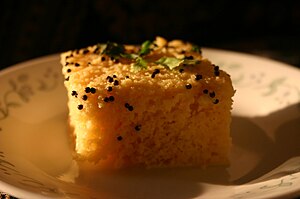
Gujarati cuisine is primarily vegetarian. The typical Gujarati thali consists of roti (rotlii in Gujarati), daal or kadhi, rice, sabzi/shaak, papad and chaas (buttermilk).
Sabzi is a dish of different combinations of vegetables and spices which may be stir fried, spicy or sweet. Gujarati cuisine can vary widely in flavour and heat based on personal and regional tastes. North Gujarat, Kathiawad, Kachchh, and South Gujarat are the four major regions of Gujarati cuisine.
Many Gujarati dishes are simultaneously sweet, salty (like handvo), and spicy. In mango season, keri no ras (fresh mango pulp) is often an integral part of the meal. Spices also vary seasonally. For example, garam masala is used much less in summer.
Gujarati snacks include sev khamani, khakhra, dal vada, methi na bhajiya, khaman, bhakharwadi and more.
Regular fasting, with diets limited to milk, dried fruit, and nuts, is a common practice,
Haryana

Cattle being common in Haryana, dairy products are a common component of its cuisine.
Specific regional dishes include kadhi, pakora, besan masala roti, bajra aloo roti, churma, kheer, bathua raita, methi gajar, singri ki sabzi and tomato chutney.
In the past, its staple diet included bajra khichdi, rabdi, onion chutney, and bajra ki roti. In non-vegetarian cuisine it includes kukad kadhai and chicken tikka masala.
Lassi, sharbat, nimbu pani and labsi (a mixture of bajra flour and lassi) are three popular non-alcoholic beverages in Haryana. However, liquor stores are common there, which cater to a large number of truck drivers.
Himachal Pradesh
The daily diet of Himachal people is similar to that of the rest of North India, including lentils, broth, rice, vegetables, and bread, although non-vegetarian cuisine is preferred. Some of the specialities of Himachal include sidu,patande, chukh, rajmah, and til chutney.
Jammu and Kashmir

The cuisine of Jammu and Kashmir is from two regions of the state: Jammu division and Kashmir Valley. Kashmiri cuisine has evolved over hundreds of years. Its first major influence was the food of the Kashmiri Hindus and Buddhists.
The cuisine was later influenced by the cultures which arrived with the invasion of Kashmir by Timur from the area of modern Uzbekistan. Subsequent influences have included the cuisines of Central Asia and the North Indian plains.

The Jammu region is famous for its sund panjeeri, patisa, rajma with rice and Kalari cheese.
Dogri food includes ambal (sour pumpkin dish), kulthein di dal, dal chawal, maa da madra (black gram lentils in yogurt) and Uriya.
Many types of pickles are made including mango, kasrod, and girgle. Street food is also famous which include various types of chaats, specially gol gappas, gulgule, chole bhature, rajma kulcha and dahi bhalla.
Jharkhand
Staple foods in Jharkhand are rice, dal and vegetables. Famous dishes include chirka roti, pittha, malpua, dhuska, arsa roti and litti chokha.
Local alcoholic drinks include handia, a rice beer, and mahua daru, made from flowers of the mahua tree (Madhuca longifolia).
Karnataka
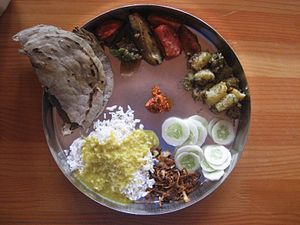
A number of dishes, such as idli, rava idli, Mysore masala dosa, etc., were invented here and have become popular beyond the state of Karnataka. Equally, varieties in the cuisine of Karnataka have similarities with its three neighbouring South Indian states, as well as the states of Maharashtra and Goa to its north. It is very common for the food to be served on a banana leaf, especially during festivals and functions.
Karnataka cuisine can be very broadly divided into Mysore/Bangalore cuisine, North Karnataka cuisine, Udupi cuisine, Kodagu/Coorg cuisine, Karavali/coastal cuisine, and Saraswat cuisine.
This cuisine covers a wide spectrum of food from pure vegetarian and vegan to meats like pork, and from savouries to sweets.
Typical dishes include bisi bele bath, jolada rotti, badanekai yennegai, holige, kadubu, chapati, idli vada, ragi rotti, akki rotti, saaru, huli, kootu, vangibath, khara bath, kesari bhath, sajjige, neer dosa, mysoore, haal bai,chiroti, benne dose, ragi mudde, and uppittu.
The Kodagu district is known for spicy pork curries, while coastal Karnataka specialises in seafood. Although the ingredients differ regionally, a typical Kannadiga oota (Kannadiga meal) is served on a banana leaf. The coastal districts of Dakshina Kannada and Udupi have slightly varying cuisines, which make extensive use of coconut in curries and frequently include seafood.
Kerala

Contemporary Kerala food includes vegetarian and non-vegetarian dishes. Fish and seafood play a major role in Kerala cuisine, as Kerala is a coastal state. An everyday Kerala meal in most households consists of rice with fish curry made of sardines, mackerel, seer fish, king fish, pomfret, prawns, shrimp, sole, anchovy, or parrotfish, (mussels, oysters, crabs, squid, scallops are not rare), and vegetable curry and stir-fried vegetables with or without coconut traditionally known as thoran or mizhukkupiratti. As Kerala has large number of inland water bodies, freshwater fish are also abundant, and part of regular meals. It is common in Kerala to have a breakfast with non-vegetarian dishes in restaurants, in contrast to other states in India. Chicken or mutton stews, lamb, chicken, beef, pork, egg curry, and fish curry with tapioca for breakfast are also widely enjoyed.
Kerala cuisine reflects its rich trading heritage. Over time, various cuisines have blended with indigenous dishes, while foreign ones have been adapted to local tastes. Significant Arab, Syrian, Portuguese, Dutch, Jewish, and Middle Eastern influences exist in this region's cuisine.

Coconuts grow in abundance in Kerala, so grated coconut and coconut milk are commonly used for thickening and flavouring. Having been a major region of spice cultivation and trade for thousands of years, the spices like black pepper, cardamom, clove, ginger, cumin and cinnamon finds extensive use in Kerala cuisine. Kerala sadhya, an elaborate vegetarian banquet prepared for festivals and ceremonies. A full-course sadhya, which consists of rice with about 20 different accompaniments and desserts is the ceremonial meal, eaten usually on celebrations such as marriages, Onam, Vishu, etc. and is served on a plantain leaf.
Most of Kerala's Hindus, except its Brahmin community, eats fish, chicken, beef, pork, eggs, and mutton. The Brahmin are famed for their vegan cuisine, especially varieties of sambar and rasam. A thick vegetable stew popular in South and Central India called avial is believed to have originated in southern Kerala. The avial, eaten widely in the state, is an important vegetarian dish in Kerala sadya. In most Kerala households, a typical meal consists of rice served along with vegetables and fish or meat dishes. Kerala also has a variety of breakfast dishes like idli, dosa, appam, idiyappam, puttu, parotta and pathiri served with sambar, coconut chutney, mutta curry (egg curry), kadala (chickpea) curry, green peas, chicken curry, beef curry and mutton curry.
The Muslim community of Kerala blend Arabian, North Indian, and indigenous Malabari cuisines, using chicken, eggs, beef, and mutton. Thalassery biryani is the only biryani variant, which is of Kerala origin having originated in Talassery, in Malabar region. The dish is significantly different from other biryani variants. Snacks like Pazham nirachathu, Unnakkai, Bread pola— made of bread, eggs, milk and a simple masala, Iftar preparations like Thari kanji, Kozhi pichuporichathu (shredded chicken), Pidi— a preparation of rice dumplings dunked in gravy,Irachi pathiri, Chatti pathiri, Meen pathiri, Neriya pathiri and Kannu vecha pathiri — roti varieties usually made of powdered rice, dishes like Kaai curry etc., are also contributions of Muslim community to the broad Kerala cuisine. The Pathanamthitta region is known for raalan and fish curries. Appam along with wine and curries of duck, pork and cured beef are popular among Syrian Christians in Central Kerala.
Popular desserts are payasam (pudding) and halwa. Payasam, especially Ambalappuzha Paalpayasam also known as Gopala Kashayam (Krishnan's potion) prepared at the 17th century Ambalappuzha Sri Krishna swami temple, is a delicacy known for its unique and flavourful taste. Interestingly, on each day the paalpayasam is prepared only after (ritualistically) seeking due permission from the presiding deity — Shri Krishna. Kerala has a number of paayasam varieties including but not limited to Paalpayasam, Vermicelli Payasam, Pradhaman, Ada Pradhaman, Chakka (Jackfruit) Pradhaman, Parippu Paayasam and more. Paayasam like Vermicelli Payasam (Semiya payasam) also finds a place in Iftar feast of Muslim communities in Kerala.
Halva is one of the most commonly found or easily recognized sweets in bakeries throughout Kerala, and originated from the Gujarathi community in Calicut. Europeans used to call the dish "sweetmeat" due to its texture, and a street in Kozhikode where became named Sweet Meat Street during colonial rule. This is mostly made from maida (highly refined wheat), and comes in various flavours, such as banana, ghee or coconut. However, karutha haluva (black haluva) made from rice is also very popular.
Ladakh

Ladakhi cuisine is from the two districts of Leh and Kargil in the union territory of Ladakh. Ladakhi food has much in common with Tibetan food, the most prominent foods being thukpa (noodle soup) and tsampa, known in Ladakhi as ngampe (roasted barley flour). Edible without cooking, tsampa makes useful trekking food.
Strictly Ladakhi dishes include skyu and chutagi, both heavy and rich soup pasta dishes, skyu being made with root vegetables and meat, and chutagi with leafy greens and vegetables. As Ladakh moves toward a cash-based economy, foods from the plains of India are becoming more common.
As in other parts of Central Asia, tea in Ladakh is traditionally made with strong green tea, butter, and salt. It is mixed in a large churn and known as gurgur cha, after the sound it makes when mixed. Sweet tea (cha ngarmo) is common now, made in the Indian style with milk and sugar. Most of the surplus barley that is produced is fermented into chang, an alcoholic beverage drunk especially on festive occasions.
Lakshadweep
The cuisine of Lakshadweep prominently features seafood and coconut. Local food consists of spicy non-vegetarian and vegetarian dishes.
The culinary influence of Kerala is quite evident in the cuisines of Lakshadweep, since the island lies in close proximity to Kerala. Coconut and sea fish serve as the foundation of most meals.
The people of Lakshadweep drink large amounts of coconut water, which is the most abundant aerated drink on the island. Coconut milk is the base for most of the curries. All the sweet or savory dishes have a touch of famous Malabar spices. Local people also prefer to have dosa, idlis, and various rice dishes.
Madhya Pradesh

The cuisine in Madhya Pradesh varies regionally. Wheat and meat are common in the north and west of the state, while the wetter south and east are dominated by rice and fish. Milk is a common ingredient in Gwalior and Indore.
The street food of Indore is well known, with shops that have been active for generations. Bhopal is known for meat and fish dishes such as rogan josh, korma, qeema, biryani, pilaf, and kebabs. On a street named Chatori Gali in old Bhopal, one can find traditional Muslim nonvegetarian fare such as paya soup, bun kabab, and nalli-nihari as some of the specialties.
Dal bafla is a common meal in the region and can be easily found in Indore and other nearby regions, consisting of a steamed and grilled wheat cake dunked in rich ghee, which is eaten with daal and ladoos.
The culinary specialty of the Malwa and Indore regions of central Madhya Pradesh is poha (flattened rice); usually eaten at breakfast with jalebi.
Beverages in the region include lassi, beer, rum and sugarcane juice. A local liquor is distilled from the flowers of the mahua tree. Date palm toddy is also popular. In tribal regions, a popular drink is the sap of the sulfi tree, which may be alcoholic if it has fermented.
Maharashtra

Maharashtrian cuisine is an extensive balance of many different tastes. It includes a range of dishes from mild to very spicy tastes. Bajri, wheat, rice, jowar, vegetables, lentils, and fruit form important components of the Maharashtrian diet.
Popular dishes include puran poli, ukdiche modak, batata wada, sabudana khichdi, masala bhat, pav bhaji, and wada pav. Poha or flattened rice is also usually eaten at breakfast. Kanda poha and aloo poha are some of the dishes cooked for breakfast and snacking in evenings.

The cuisine of Vidarbha uses groundnuts, poppy seeds, jaggery, wheat, jowar, and bajra extensively. A typical meal consists of rice, roti, poli, or bhakar, along with varan and aamtee—lentils and spiced vegetables. Cooking is common with different types of oil.
Savji food from Vidarbha is well known all over Maharashtra. Savji dishes are very spicy and oily. Savji mutton curries are very famous.
Like other coastal states, an enormous variety of vegetables, fish, and coconuts exists, where they are common ingredients. Peanuts and cashews are often served with vegetables. Grated coconuts are used to flavour many types of dishes, but coconut oil is not widely used; peanut oil is preferred.
Kokum, most commonly served chilled, in an appetiser-digestive called sol kadhi, is prevalent. During summer, Maharashtrians consume panha, a drink made from raw mango.
Malwani

Malwani cuisine is a specialty of the tropical area which spans from the shore of Deogad Malwan to the southern Maharashtrian border with Goa. The unique taste and flavor of Malwani cuisine comes from Malwani masala and use of coconut and kokam.
The staple foods are rice and fish. Various kinds of red and green fish, prawns, crab, and shellfish curries (also called mashacha sar in the Malwani language) are well known, along with kombadi (chicken) wade and mutton prepared Malwani style. Mohari mutton is also one of the distinct delicacies of Malwani cuisine.
A large variety of fish is available in the region, which include surmai, karali, bangada, bombil (Bombay duck), paplet (pomfret), halwa, tarali, suandale, kolambi (prawns), tisari (shellfish), kalwa (stone fish) and kurli (crab).
All these fish are available in dried form, including prawns, which are known as sode. Local curries and chatanis are also prepared with dried fish.
Different types of rice breads and pancakes add to the variety of Malwani cuisine and include tandlachi bhakari, ghawane, amboli, patole, appe, tandalachi and shavai (rice noodles). These rice breads can be eaten specially flavored with coconut milk, fish curries, and chicken or mutton curries.
Sole kadi made from kokam and coconut milk is a signature appetizer drink . For vegetarians, Malwani delicacies include alloochi bhaji, alloochi gathaya, kalaya watanyacha, and sambara (black gram stew).
The sweets and desserts include ukadiche modak, Malawani khaje, khadakahde kundiche ladu, shegdanyache ladu, tandalchi kheer, and tandalachi shavai ani ras (specially flavored with coconut milk).
Manipur
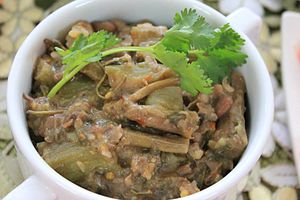
Manipuri cuisine is represented by the cuisine of the Meitei people who form the majority population in the central plain. Meitei food are simple, tasty, organic and healthy. Rice with local seasonal vegetables and fish form the main diet.
Most of the dishes are cooked like vegetable stew, flavored with either fermented fish called ngari, or dried and smoked fish.
The most popular Manipuri dish is eromba, a preparation of boiled and mashed vegetables, often including carrots, potatoes or beans, mixed with chilli and roasted fermented fish.
Another popular dish is the savory cake called paknam, made of a lentil flour stuffed with various ingredients such as banana inflorescence, mushrooms, fish, vegetables etc., and baked covered in turmeric leaves.
Along with spicy dishes, a mild side dish of steamed or boiled sweet vegetables are often served in the daily meals. The Manipuri salad dish called singju, made of finely julienned cabbage, green papaya, and other vegetables, and garnished with local herbs, toasted sesame powder and lentil flour is extremely popular locally, and often found sold in small street side vendors.
Singju is often served with bora, which are fritters of various kinds, and also kanghou, or oil-fried spicy veggies. Cooked and fermented soybean is a popular condiment in all Manipuri kitchens.
The staple diet of Manipur consists of rice, fish, large varieties of leafy vegetables (of both aquatic and terrestrial). Manipuris typically raise vegetables in a kitchen garden and rear fishes in small ponds around their house. Since the vegetables are either grown at home or obtained from local market, the cuisines are very seasonal, each season having its own special vegetables and preparations.
The taste is very different from mainland Indian cuisines because of the use of various aromatic herbs and roots that are peculiar to the region. They are however very similar to the cuisines of Southeast, East, and Central Asia, Siberia, Micronesia and Polynesia.
Meghalaya

Meghalayan cuisine is unique and different from other Northeastern Indian states. Spiced meat is common, from goats, pigs, fowl, ducks, chickens, and cows. In the Khasi and Jaintia Hills districts, common foods include jadoh, ki kpu, tung-rymbai, and pickled bamboo shoots.
Other common foods in Meghalaya include minil songa (steamed sticky rice), sakkin gata, and momo dumplings.
Like other tribes in the northeast, the Garos ferment rice beer, which they consume in religious rites and secular celebrations.
Mizoram
The cuisine of Mizoram differs from that of most of India, though it shares characteristics to other regions of Northeast India and North India.
Rice is the staple food of Mizoram, while Mizos love to add non-vegetarian ingredients in every dish. Fish, chicken, pork and beef are popular meats among Mizos. Dishes are served on fresh banana leaves. Most of the dishes are cooked in mustard oil.
Meals tend to be less spicy than in most of India. Mizos love eating boiled vegetables along with rice. A popular dish is bai, made from boiling vegetables (spinach, eggplant, beans, and other leafy vegetables) with bekang (fermented soya beans) or sa-um, fermented pork fat served with rice. Sawhchiar is another common dish, made of rice and cooked with pork or chicken.
Nagaland

The cuisine of Nagaland reflects that of the Naga people. It is known for exotic pork meats cooked with simple and flavourful ingredients, like the extremely hot bhut jolokia (ghost chili) pepper, fermented bamboo shoots, and akhuni ( fermented soya beans). Another unique and strong ingredient used by the Naga people, is the fermented fish known as ngari.
Fresh herbs and other local greens also feature prominently in the Naga cuisine. The Naga use oil sparingly, preferring to ferment, dry, and smoke their meats and fish.
Traditional homes in Nagaland have external kitchens that serve as smokehouses.
A typical meal consists of rice, meat, a chutney, a couple of stewed or steamed vegetable dishes, flavored with ngari or akhuni. Desserts usually consist of fresh fruits.
Odisha

The cuisine of Odisha relies heavily on local ingredients. Flavours are usually subtle and delicately spiced. Fish and other seafood, such as crab and shrimp, are very popular, and chicken and mutton are also consumed.
Panch phutana, a mix of cumin, mustard, fennel, fenugreek and kalonji (nigella), is widely used for flavouring vegetables and dals, while garam masala and turmeric are commonly used for meat-based curries.
Pakhala, a dish made of rice, water, and dahi (yogurt), that is fermented overnight, is very popular in summer in rural areas. Oriyas are very fond of sweets, so dessert follows most meals.
Popular Oriya dishes include anna, kanika, dalma, khata (tamato and oou), dali (different types of lentils, i.e. harada [red gram], muga [green gram], kolatha [horsegram], etc.), spinach and other green leaves, and alu-bharta (mashed potato) along with pakhala.
Odisha and neighboring West Bengal both claim to be the origin of rasgulla, each state having a geographical indication for their regional variety of the dessert. Odisha is also known for its chhena-based sweets, including chhena poda, chhena gaja, chhena jhili, and rasabali.
Puducherry
The union territory of Puducherry was a French colony for around 200 years, making French cuisine a strong influence on the area. Tamil cuisine is eaten by the territory's Tamil majority. The influence of the neighbouring areas, such as Andhra Pradesh and Kerala, is also visible on the territory's cuisine.
Some favourite dishes include coconut curry, tandoori potato, soya dosa, podanlangkai (snake gourd chutney), curried vegetables, stuffed cabbage, and baked beans.
Punjab

The cuisine of Punjab is known for its diverse range of dishes. It is closely related to the cuisine of the neighbouring Punjab province of Pakistan.
The state, being an agriculture center, is abundant with whole grains, vegetables, and fruits. Home-cooked and restaurant Punjabi cuisine can vary significantly.
Restaurant-style Punjabi cooking puts emphasis on creamy textured foods by using ghee, butter and cream, while home-cooked meals center around whole wheat, rice, and other ingredients flavored with various kinds of masalas.
Common dishes cooked at home are roti with daal and dahi (yogurt) with a side chutney and salad that includes raw onion, tomato, cucumber, etc.
The meals are also abundant of local and seasonal vegetables usually sautéed with spices such as cumin, dried coriander, red chili powder, turmeric, black cloves, etc. Masala chai is a favorite drink and is consumed in everyday life and at special occasions.
Many regional differences exist in the Punjabi cuisine based on traditional variations in cooking similar dishes, food combinations, preference of spice combination, etc. It is clear that "the food is simple, robust, and closely linked to the land."
Certain dishes exclusive to Punjab, such as makki di roti and sarson da saag, dal makhani, and others are a favorite of many.
The masala in a Punjabi dish traditionally consists of onion, garlic, ginger, cumin, garam masala, salt, turmeric, tomatoes sauteed in mustard oil. Tandoori food is a Punjabi specialty. Dishes like Bhatti da murgh also known as tandoori chicken, Chicken hariyali kabab, Achari paneer tikka, fish ajwaini tikka and Amritsari kulcha are some popular tandoori foods from Punjab.

Common meat dishes in this region are Bhakra curry (goat) and fish dishes. Dairy products are regularly enjoyed and usually accompany main meals in the form of dahi, milk, and milk-derived products such as lassi, paneer, and more.
Punjab has a large number of people following the Sikh religion who traditionally follow a vegetarian diet (which includes plant-derived foods, milk, and milk by-products. See diet in Sikhism) in accordance to their beliefs.
No description of Punjabi cuisine is complete without the myriad of famous desserts, such as kheer, gajar ka halwa, sooji (cream of wheat) halwa, rasmalai, gulab jamun and jalebi. Most desserts are ghee or dairy-based, use nuts such as almonds, walnuts, pistachios, cashews, and, raisins.
Many of the most popular elements of Anglo-Indian cuisine, such as tandoori foods, naan, pakoras and vegetable dishes with paneer, are derived from Punjabi styles.
Punjabi food is well liked in the world for its flavors, spices, and, versatile use of produce, and so it is one of the most popular cuisines from the sub-continent. Last but not least are the chhole bhature and chhole kulche> which are famous all over the North India.
Cooking in Rajasthan, an arid region, has been strongly shaped by the availability of ingredients. Food is generally cooked in milk or ghee, making it quite rich. Gram flour is a mainstay of Marwari food mainly due to the scarcity of vegetables in the area.
Historically, food that could last for several days and be eaten without heating was preferred. Major dishes of a Rajasthani meal may include daal-baati, tarfini, raabdi, ghevar, bail-gatte, panchkoota, chaavadi, laapsi, kadhi and boondi. Typical snacks include bikaneri bhujia, mirchi bada, pyaaj kachori, and dal kachori.
Daal-baati is the most popular dish prepared in the state. It is usually supplemented with choorma, a mixture of finely ground baked rotis, sugar and ghee.
Rajasthan is also influenced by the Rajput community who have liking for meat dishes. Their diet consisted of game meat and gave birth to dishes like laal maans, safed maas,
In Sikkim, various ethnic groups such as the Nepalese, Bhutias, and Lepchas have their own distinct cuisines. Nepalese cuisine is very popular in this area.
Rice is the staple food of the area, and meat and dairy products are also widely consumed. For centuries, traditional fermented foods and beverages have constituted about 20 percent of the local diet.
Depending on altitudinal variation, finger millet, wheat, buckwheat, barley, vegetables, potatoes, and soybeans are grown. Dhindo, daal bhat, gundruk, momo, gya thuk, ningro, phagshapa, and sel roti are some of the local dishes.
Alcoholic drinks are consumed by both men and women. Beef is eaten by Bhutias.
Sindhi cuisine refers to the native cuisine of the Sindhi people from the Sindh region, now in Pakistan. While Sindh is not geographically a part of modern India, its culinary traditions persist, due to the sizeable number of Hindu Sindhis who migrated to India following the independence of Pakistan in 1947, especially in Sindhi enclaves such as Ulhasnagar and Gandhidam.
A typical meal in many Sindhi households includes wheat-based flatbread (phulka) and rice accompanied by two dishes, one with gravy and one dry. Lotus stem (known as kamal kakri) is also used in Sindhi dishes. Cooking vegetables by deep frying is common.
Some regular Sindhi dishes are sindhi kadhi, sai bhaji, koki and besan bhaji. Ingredients frequently used are mango powder, tamarind, kokum flowers, and dried pomegranate seeds.
Tamil Nadu

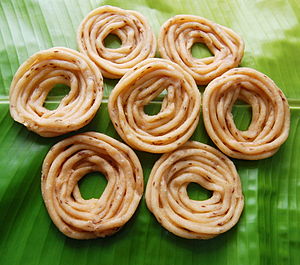
Tamil Nadu is noted for its deep belief that serving food to others is a service to humanity, as is common in many regions of India. The region has a rich cuisine involving both traditional non-vegetarian and vegetarian dishes.
Tamil food is characterised by its use of rice, legumes, and lentils, along with distinct aromas and flavours achieved by the blending of spices such as mustard, curry leaves, tamarind, coriander, ginger, garlic, chili pepper, cinnamon, clove, cardamom, cumin, nutmeg, coconut and rose water.
The traditional way of eating involves being seated on the floor, having the food served on a plantain leaf, and using the right hand to eat. After the meal the plantain leaf is discarded but becomes food for free-ranging cattle and goats.
A meal (called saapadu) consists of rice with other typical Tamil dishes on a plantain leaf. A typical Tamilian would eat on a plantain leaf as it is believed to give a different flavour and taste to food. Also growing in popularity are stainless-steel trays, plates with a selection of different dishes in small bowls.
Tamil food is characterized by tiffin, which is a light food taken for breakfast or dinner, and meals which are usually taken during lunch. The word "curry" is derived from the Tamil kari, meaning something similar to "sauce".
Southern regions such as Tirunelveli, Madurai, Paramakudi, Karaikudi, Chettinad and Kongu Nadu are noted for their spicy non-vegetarian dishes. Dosa, idli, pongal and biryani are some of the popular dishes that are eaten with chutney and sambar. Fish and other seafoods are also very popular, because the state is located on the coast. Chicken and goat meat are the predominantly consumed meats in Tamil Nadu.
A typical Tamil vegetarian meal is heavily dependent on rice, vegetables and lentil preparations such as rasam and sambar, but there are variations. They have influenced Kerala as well in their kootu, arachi vitta sambhar and molagootals (mulligatawny soup).
As mentioned above, the Chettinad variety of food uses many strong spices, such as pepper, garlic, fennel seeds and onions. Tamil food tends to be spicy compared to other parts of India so there is a tradition of finishing the meal with dahi (yogurt) is considered a soothing end to the meal.
Notably, Tamil Brahmin cuisine, the food of the Iyers and Iyengar community, is characterized by slightly different meal times and meal structures compared to other communities within the state.
Historically vegetarian, the cuisine is known for its milder flavor and avoidance of onion and garlic (although this practice appears to be disappearing with time).
After a light morning meal of filter coffee and different varieties of porridges (oatmeal and janata kanji are immensely popular), the main meal of the day, lunch/brunch is usually at 11 am and typically follows a two-three course meal structure. Steamed rice is the main dish, and is always accompanied by a seasonally steamed/sauteed vegetable (poriyal), and two or three types of tamarind stews, the most popular being sambhar and rasam. The meal typically ends with thair sadham (rice with yogurt), usually served with pickled mangoes or lemons.
Tiffin is the second meal of the day and features several breakfast favorites such as idli, rava idli, upma, dosa varieties, and vada, and is usually accompanied by chai.
Dinner is the simplest meal of the day, typically involving leftovers from either lunch or tiffin. Fresh seasonal fruit consumed in the state include bananas, papaya, honeydew and canteloupe melons, jackfruit, mangos, apples, kasturi oranges, pomegranates, and nongu (hearts of palm).
Telangana

The cuisine of Telangana consists of the Telugu cuisine, of Telangana's Telugu people as well as Hyderabadi cuisine (also known as Nizami cuisine), of Telangana's Hyderabadi Muslim community.
Hyderabadi food is based heavily on non-vegetarian ingredients, while Telugu food is a mix of both vegetarian and non-vegetarian ingredients. Telugu food is rich in spices and chillies are abundantly used. The food also generally tends to be more on the tangy side with tamarind and lime juice both used liberally as souring agents.
Rice is the staple food of Telugu people. Starch is consumed with a variety of curries and lentil soups or broths. Vegetarian and non-vegetarian foods are both popular.
Hyderabadi cuisine includes popular delicacies such as biryani, haleem, Baghara baingan and kheema, while Hyderabadi day-to-day dishes see some similarities to Telanganite Telugu food, with its use of tamarind, rice, and lentils, along with meat.
Tripura

The Tripuri people are the original inhabitants of the state of Tripura in northeast India. Today, they comprise the communities of Tipra, Reang, Jamatia, Noatia, and Uchoi, among others. The Tripuri are non-vegetarian, although they have a minority of Vaishnavite vegetarians.
The major ingredients of Tripuri cuisine include vegetables, herbs, pork, chicken, mutton, fishes, turtle, shrimps, crabs, freshwater mussels, periwinkles, edible freshwater snails and frogs.
Traditionally, Uttar Pradeshi cuisine consists of Awadhi, Bhojpuri, and Mughlai cuisine, though a vast majority of the state is vegetarian, preferring dal, roti, sabzi, and rice. Pooris and kachoris are eaten on special occasions.
Well-known dishes include kebabs, dum biryani, and various mutton recipes. Sheer qorma, ghevar, gulab jamun, kheer, and ras malai are some of the popular desserts in this region.
Awadhi cuisine (Hindi: अवधी खाना) is from the city of Lucknow, which is the capital of the state of Uttar Pradesh in Central-South Asia and Northern India, and the cooking patterns of the city are similar to those of Central Asia, the Middle East, and other parts of Northern India. The cuisine consists of both vegetarian and non-vegetarian dishes.
Awadh has been greatly influenced by Mughal cooking techniques, and the cuisine of Lucknow bears similarities to those of Central Asia, Kashmir, Punjab and Hyderabad. The city is also known for its Nawabi foods. The bawarchis and rakabdars of Awadh gave birth to the dum style of cooking or the art of cooking over a slow fire, which has become synonymous with Lucknow today. Their spread consisted of elaborate dishes like kebabs, kormas, biryani, kaliya, nahari-kulchas, zarda, sheermal, roomali rotis, and warqi parathas.
The richness of Awadh cuisine lies not only in the variety of cuisine but also in the ingredients used like mutton, paneer, and rich spices, including cardamom and saffron.
Mughlai cuisine is a style of cooking developed in the Indian subcontinent by the imperial kitchens of the Mughal Empire. It represents the cooking styles used in North India (especially Uttar Pradesh).
The cuisine is strongly influenced by Central Asian cuisine, the region where the Chagatai-Turkic Mughal rulers originally hailed from, and has strongly influenced the regional cuisines of Kashmir and the Punjab region.
The tastes of Mughlai cuisine vary from extremely mild to spicy, and is often associated with a distinctive aroma and the taste of ground and whole spices.
A Mughlai course is an elaborate buffet of main course dishes with a variety of accompaniments.
Uttarakhand

Food from Uttrakhand is known to be healthy and wholesome to suit the high-energy necessities of the cold, mountainous region. It is a high-protein diet that makes heavy use of pulses and vegetables. Traditionally, it is cooked over wood or charcoal fire mostly using iron utensils.
While making use of condiments such as jeera, haldi and rai common in other Indian cuisines, Uttarakhand cuisine also use exotic ingredients such as jambu, timmer, ghandhraini and bhangira.
Although the people in Uttarakhand also make dishes common in other parts of northern India, several preparations are unique to Uttarakhand such as rus, chudkani, dubuk, chadanji, jholi, kapa, and more.
Among dressed salads and sauces, kheere ka raita, nimbu mooli ka raita, daarim ki khatai and aam ka fajitha are also popular.
The cuisine mainly consists of food from two different sub-regions, Garhwal and Kumaon, though their basic ingredients are the same. Both Kumaoni and Garhwali styles make liberal use of ghee, lentils or pulses, vegetables and bhaat (rice). They also use badi (sun-dried urad dal balls) and mungodi (sun-dried moong dal balls) as substitutes for vegetables at times.
During festivals and other celebrations, the people of Uttarakhand prepare special refreshments which include both salty preparations such as bada and sweet preparations such as pua and singal. Uttarakhand also has several sweets (mithai) such as singodi, bal-mithai, and malai laddu, native to its traditions.
Gallery
- North India
-
Daulat Chaat in Old Delhi
-
Butter Chicken & Butter Naan
-
Kashmiri Pulav
- West India
-
Locho and Idada
-
Chhole Upma
-
Tandoori Lemonfish fry
- East India
-
Plantain Dumplings
-
Luchi Alur Torkari
-
Bamboo steam rice
-
Tamul Paan
-
Prosad Thali
-
Tan Ngang
- South India
-
Khotto
-
Prawn Biryani
Hindu people fast on days such as Ekadashi, in honour of Lord Vishnu or his Avatars, Chaturthi in honour of Ganesh, Mondays in honour of Shiva, or Saturdays in honour of Hanuman or Saturn.
Only certain kinds of foods are allowed to be eaten. These include milk and other dairy products (such as dahi), fruit, and Western food items such as sago, potatoes, purple-red sweet potatoes, amaranth seeds, nuts and (shama millet).
Popular fasting dishes include farari chevdo, sabudana khichadi, and peanut soup.
Diaspora and fusion cuisines
The interaction of various Indian diaspora communities with the native cultures in their new homes has resulted in the creation of many fusion cuisines, which blend aspects of Indian and other international cuisines. These cuisines tend to interpolate Indian seasoning and cooking techniques into their own national dishes.
Indian Chinese cuisine

Indian Chinese cuisine, also known as Indo-Chinese cuisine originated in the 19th century among the Chinese community of Calcutta, during the immigration of Hakka Chinese from Canton (present-day Guangzhou) seeking to escape the First and Second Opium Wars and political instability in the region. Upon exposure to local Indian cuisine, they incorporated many spices and cooking techniques into their own cuisine, thus creating a unique fusion of Indian and Chinese cuisine.
After 1947, many Cantonese immigrants opened their own restaurants in Calcutta, whose dishes combined aspects of Indian cuisine with Cantonese cuisine. In other parts of India, Indian Chinese cuisine is derived from Calcutta-Chinese cuisine, but bears little resemblance to their Chinese counterparts as the dishes tend to be flavoured with cumin, coriander seeds, and turmeric, which with a few regional exceptions, are not traditionally associated with Chinese cuisine. Chilli, ginger, garlic and dahi (yogurt) are also frequently used in dishes.
Popular dishes include Chicken Manchurian, chicken lollipop, chilli chicken, Hakka noodles, Hunan chicken, chow mein, and Szechwan fried rice.
Soups such as Manchow soup and sweet corn soup are very popular, whereas desserts include ice cream on honey-fried noodles and date pancakes.
Chowmein is now known as one of the most favorite Chinese dishes in India. Especially in West Bengal, it is one of the most loved street foods.
Indian Thai cuisine
Thai cuisine was influenced by Indian cuisine, like as recorded by the Thai monk Buddhadasa Bhikku in his writing ‘India's Benevolence to Thailand’. He wrote that Thai people learned how to use spices in their food in various ways from Indians. Thais also obtained the methods of making herbal medicines (Ayurveda) from the Indians. Some plants like sarabhi of family Guttiferae, kanika or harsinghar, phikun or Mimusops elengi and bunnak or the rose chestnut etc. were brought from India.
Malaysian Indian cuisine, or the cooking of the ethnic Indian communities in Malaysia consists of adaptations of authentic dishes from India, as well as original creations inspired by the diverse food culture of Malaysia.
A typical Malaysian Indian dish is likely to be redolent with curry leaves, whole and powdered spice, and contains fresh coconut in various forms.
Ghee is still widely used for cooking, although vegetable oils and refined palm oils are now commonplace in home kitchens.
Indian Singaporean cuisine
Indian Singaporean cuisine refers to foods and beverages produced and consumed in Singapore that are derived, wholly or in part, from South Asian culinary traditions.
The great variety of Singaporean food includes Indian food, which tends to be Tamil cuisine, especially local Tamil Muslim cuisine, although North Indian food has become more visible recently.
Indian dishes have become modified to different degrees, after years of contact with other Singaporean cultures, and in response to locally available ingredients, as well as changing local tastes.
Indian Indonesian cuisine

Indian-Indonesian cuisine refers to food and beverages in Indonesian cuisine that have influenced Indian cuisine—especially from Tamil, Punjabi, and Gujarati cuisine. These dishes are well integrated, such as appam, biryani, murtabak and curry.
Indian Filipino cuisine
Filipino cuisine, found throughout the Philippines archipelago, has been historically influenced by the Indian cuisine. Indian influences can also be noted in rice-based delicacies such as bibingka (analogous to the Indonesian bingka), puto, and puto bumbong, where the latter two are plausibly derived from the south Indian puttu, which also has variants throughout Maritime Southeast Asia (e.g. kue putu, putu mangkok).
The kare-kare, more popular in Luzon, on the other hand could trace its origins from the Seven Years' War when the British occupied Manila from 1762 to 1764 with a force that included Indian sepoys, who had to improvise Indian dishes given the lack of spices in the Philippines to make curry. This is said to explain the name and its supposed thick, yellow-to-orange annatto and peanut-based sauce, which alludes to a type of curry.
Atchara of Philippines originated from the Indian achar, which was transmitted to the Philippines via the acar of the Indonesia, Malaysia, and Brunei.
Anglo-Indian cuisine
Anglo-Indian cuisine developed during the period of British colonial rule in India, as British officials interacted with their Indian cooks.
Well-known Anglo-Indian dishes include chutneys, salted beef tongue, kedgeree, ball curry, fish rissoles, and mulligatawny soup.
Desserts
Many Indian desserts, or mithai, are fried foods made with sugar, milk or condensed milk. Ingredients and preferred types of dessert vary by region. In the eastern part of India, for example, most are based on milk products.
Many are flavoured with almonds and pistachios, spiced with cardamon, nutmeg, cloves and black pepper, and decorated with nuts, or with gold or silver leaf. Popular Indian desserts include rasogolla, gulab jamun, jalebi, laddu, and peda.
Beverages
Non-alcoholic beverages
Tea is a staple beverage throughout India, since the country is one of the largest producers of tea in the world. The most popular varieties of tea grown in India include Assam tea, Darjeeling tea and Nilgiri tea. It is prepared by boiling the tea leaves in a mix of water, milk, and spices such as cardamom, cloves, cinnamon, and ginger. In India, tea is often enjoyed with snacks like biscuits and pakoda.
Coffee is another popular beverage, but more popular in South India. Coffee is also cultivated in some parts of India. There are two varieties of coffee popular in India, which include Indian filter coffee and instant coffee.
Lassi is a traditional dahi (yogurt)-based drink in India. It is made by blending yogurt with water or milk and spices. Salted lassi is more common in villages of Punjab and in Porbandar, Gujarat. Traditional lassi is sometimes flavoured with ground roasted cumin. Lassi can also be flavoured with ingredients such as sugar, rose water, mango, lemon, strawberry, and saffron.
Sharbat is a sweet cold beverage prepared from fruits or flower petals. It can be served in concentrate form and eaten with a spoon, or diluted with water to create a drink. Popular sharbats are made from plants such as rose, sandalwood, bel, gurhal (hibiscus), lemon, orange, pineapple, sarasaparilla and kokum, falsa (Grewia asiatica). In Ayurveda, sharbats are believed to hold medicinal value.
Thandai is a cold drink prepared with a mixture of almonds, fennel seeds, watermelon kernels, rose petals, pepper, poppy seeds, cardamom, saffron, milk and sugar. It is native to India and is often associated with the Maha Shivaratri and Holi or Holla mahalla festival. Sometimes bhaang (cannabis) is added to prepare special thandai.
Other beverages include nimbu pani (lemonade), chaas, badam doodh (almond milk with nuts and cardamom), Aam panna, kokum sharbat, and coconut water.
Modern carbonated cold drinks unique to southern India include beverages, such as panner soda or goli soda, a mixture of carbonated water, rose water, rose milk, and sugar, naranga soda, a mixture of carbonated water, salt and lemon juice, and nannari sarbath, a mixture with sarasaparilla.
-
Darjeeling tea in varieties.
-
Indian filter coffee is popular in Southern India.
-
Badam milk
-
Holi Special Chilled Thandai
Alcoholic beverages
Beer

Most beers in India are either lagers (4.8 percent alcohol) or strong lagers (8.9 percent). The Indian beer industry has witnessed steady growth of 10–17 percent per year over the last ten years. Production exceeded 170 million cases during the 2008–2009 financial year. With the average age of the population decreasing and income levels on the rise, the popularity of beer in the country continues to increase.
Other popular alcoholic drinks in India include fenny, a Goan liquor made from either coconut or the juice of the cashew apple. The state of Goa has registered for a geographical indicator to allow its fenny distilleries to claim exclusive rights to production of liquor under the name "fenny."
Hadia is a rice beer, created by mixing herbs with boiled rice and leaving the mixture to ferment for around a week. It is served cold and is less alcoholic than other Indian liquors. Chuak is a similar drink from Tripura.
Palm wine, locally known as neera, is a sap extracted from inflorescences of various species of toddy palms.
Chhaang is consumed by the people of Sikkim and the Darjeeling Himalayan hill region of West Bengal. It is drunk cold or at room temperature in summer, and often hot during cold weather. Chhaang is similar to traditional beer, brewed from barley, millet, or rice.
Kallu (Chetthu Kallu) is a popular natural alcohol extracted from coconut and pine trees in Kerala. It is sold in local Kallu shops and is consumed with fried fish and chicken. Its alcoholic content is increased by addition of distilled alcohol.
Eating habits

Indians consider a healthy breakfast important. They generally prefer to drink tea or coffee with breakfast, though food preferences vary regionally. North Indian people prefer roti, parathas, and a vegetable dish accompanied by achar (a pickle) and some curd. Various types of packaged pickles are available in the market. One of the oldest pickle-making companies in India is Harnarains, which started in the 1860s in Old Delhi.
People of Gujarat prefer dhokla and milk, while south Indians prefer idli and dosa, generally accompanied by sambhar or sagu and various chutneys.
Traditional lunch in India usually consists of a main dish of rice in the south and the east, and whole-wheat rotis in the north. It typically includes two or three kinds of vegetables, and sometimes items such as kulcha, naan, or parathas. Paan (stuffed, spiced and folded betel leaves) which aids digestion is often eaten after lunch and dinner in many parts of India.
Indian families often gather for "evening snack time", similar to tea time to talk and have tea and snacks.
Dinner is considered the main meal of the day. Also, many households, especially in north and central India, prefer having sweets after the dinner (similar to the Western concept of dessert after meals).
Dietary practices
In India people often follow dietary practices based on their religious belief:
- Some Hindu communities consider beef taboo since they believed that Hindu scriptures condemn cow slaughter. Cow slaughter has been banned in many states of India. However, these restrictions are not followed in the North-Eastern states, West Bengal and Kerala.
- Vaishnavism followers generally are strict lacto-vegetarians due to an emphasis on Ahimsa. They also do not consume garlic and onions.
- Jains follow a strict form of lacto-vegetarianism, known as Jain vegetarianism, which in addition to being completely lacto-vegetarian, also excludes all root vegetables such as carrots and potatoes because when the root is pulled up, organisms that live around the root also die.
- Muslims do not eat pork or pork products.
- Except in certain North-Eastern regions, canines are not considered suitable for consumption.
Traditionally, meals in India are eaten while seated either on the floor, or on very low stools or mattress. Food is most often eaten with the hands rather than cutlery.
Often roti is used to scoop curry without allowing it to touch the hand. In the wheat-producing north, a piece of roti is gripped with the thumb and middle finger and ripped off while holding the roti down with the index finger.
A somewhat different method is used in the south for dosai, adai, and uththappam, where the middle finger is pressed down to hold the bread and the forefinger and thumb used to grip and separate a small part. Traditional serving styles vary regionally throughout India.
Contact with other cultures has affected Indian dining etiquette. For example, the Anglo-Indian middle class commonly uses spoons and forks, as is traditional in Western culture.
In South India, cleaned banana leaves, which can be disposed of after meals, are used for serving food. When hot food is served on banana leaves, the leaves add distinctive aromas and taste to the food. Leaf plates are less common today, except on special occasions.
Indian migration has spread the culinary traditions of the subcontinent throughout the world. These cuisines have been adapted to local tastes, and have also affected local cuisines. The international appeal of curry has been compared to that of pizza. Indian tandoor dishes such as chicken tikka also enjoy widespread popularity.
Australia
A Roy Morgan Research survey taken between 2013 and 2018 found that Indian cuisine was the top-rated international food among 51% of Australians, behind Chinese, Italian, and Thai.
Canada
As in the United Kingdom and the United States, Indian cuisine is widely available in Canada, especially in the cities of Toronto, Vancouver, and Ottawa where the majority of Canadians of South Asian heritage live.
China
Indian food is gaining popularity in China, where there are many Indian restaurants in Beijing, Shanghai, and Shenzhen. Hong Kong alone has more than 50 Indian restaurants, some of which date back to the 1980s. Most of the Indian restaurants in Hong Kong are in Tsim Sha Tsui.
Middle East
The Indian culinary scene in the Middle East has been influenced greatly by the large Indian diaspora in these countries. Centuries of trade relations and cultural exchange resulted in a significant influence on each region's cuisines. The use of the tandoor, which originated in northwestern India,< is an example.
The large influx of Indian expatriates into Middle Eastern countries during the 1970s and 1980s led to a boom in Indian restaurants to cater to this population and was also widely influenced by the local and international cuisines.
Nepal
Indian cuisine is available in the streets of Nepalese cities, including Kathmandu and Janakpur.
Southeast Asia

Other cuisines which borrow inspiration from Indian cooking styles include Cambodian, Lao, Filipino, Vietnamese, Indonesian, Thai, and Burmese cuisines. The spread of vegetarianism in other parts of Asia is often credited to Hindu and Buddhist practices.
Indian cuisine is very popular in Southeast Asia, due to the strong Hindu and Buddhist cultural influence in the region. Indian cuisine has had considerable influence on Malaysian cooking styles and also enjoys popularity in Singapore. There are numerous North and South Indian restaurants in Singapore, mostly in Little India.
Singapore is also known for fusion cuisine combining traditional Singaporean cuisine with Indian influences. Fish head curry, for example, is a local creation. Indian influence on Malay cuisine dates to the 19th century.
United Kingdom

The UK's first Indian restaurant, the Hindoostanee Coffee House, opened in 1810. By 2003, there were as many as 10,000 restaurants serving Indian cuisine in England and Wales alone. According to Britain's Food Standards Agency, the Indian food industry in the United Kingdom is worth 3.2 billion pounds, accounts for two-thirds of all eating out in the country, and serves about 2.5 million customers every week.
One of the best known examples of British Indian restaurant cuisine is chicken tikka masala, which has also been called "a true British national dish."
Ireland
Ireland's first Indian restaurant, the Indian Restaurant and Tea Rooms, opened in 1908 on Sackville Street, now O'Connell Street, in Dublin. Today, Indian restaurants are commonplace in most Irish cities and towns. Non-Chinese Asians are the fastest growing ethnic group in Ireland.
United States
A survey by The Washington Post in 2007 stated that more than 1,200 Indian food products had been introduced into the United States since 2000. There are numerous Indian restaurants across the US, which vary based on regional culture and climate. North Indian and South Indian cuisines are especially well represented. Most Indian restaurants in the United States serve Americanized versions of North Indian food, which is generally less spicy than its Indian equivalents.
At sit-down restaurants with North Indian cuisine (the most common), complimentary papadum is served with three dipping sauces—typically hari chutney (mint and cilantro), imli chutney (taramind), and a spicy red chili or onion chutney—in place of European-style bread before the meal.
関連項目
Lua error in package.lua at line 80: module 'Module:Portal/images/aliases' not found.
- Buddhist vegetarianism/ja
- Diet in Hinduism/ja
- Diet in Sikhism/ja
- Jain vegetarianism/ja
- Indian bread/ja
- Indian Chinese cuisine/ja
- Indian tea culture/ja
- List of Indian dishes/ja
- List of Indian pickles/ja
- List of snack foods from the Indian subcontinent/ja
- List of Indian soups and stews/ja
- List of plants used in Indian cuisine/ja
- North East Indian cuisine/ja
- South Asian pickle/ja
- South Indian cuisine/ja
- Street food of Chennai/ja
- Street food of Mumbai/ja
書誌
- Pat Chapman. India: Food & Cooking, New Holland, London — ISBN 978-1-84537-619-2 (2007)
外部リンク
| この記事は、クリエイティブ・コモンズ・表示・継承ライセンス3.0のもとで公表されたウィキペディアの項目Indian cuisine(24 December 2022編集記事参照)を翻訳して二次利用しています。 |
